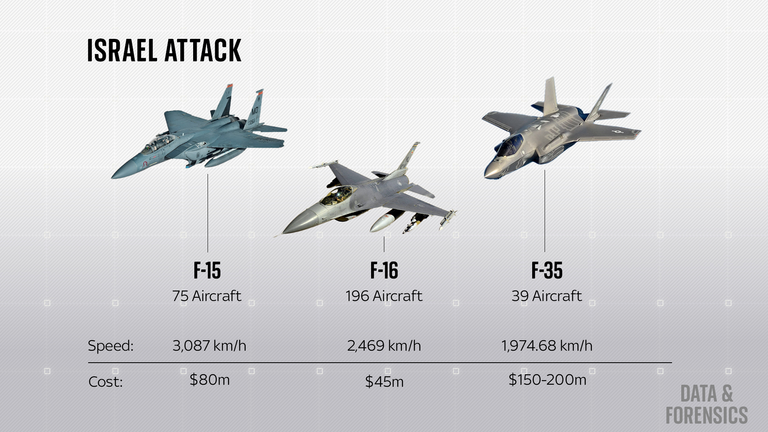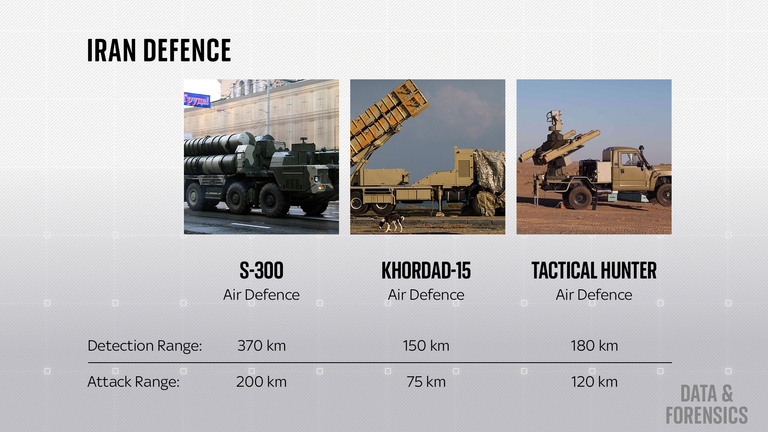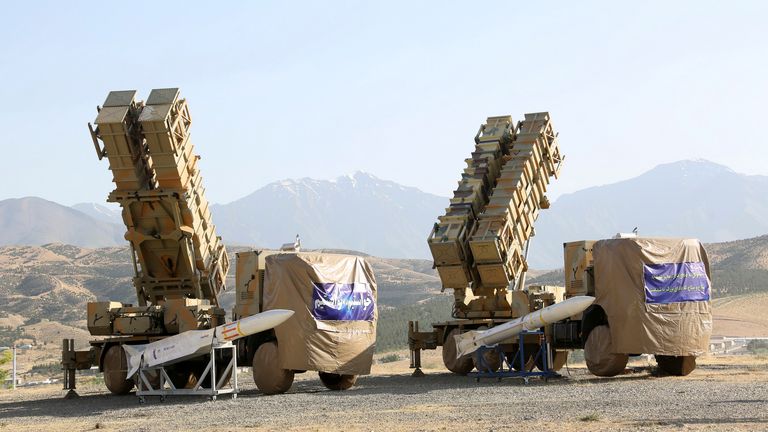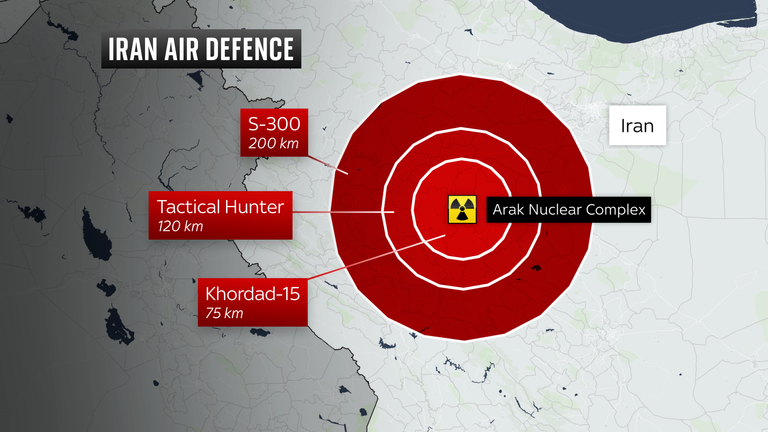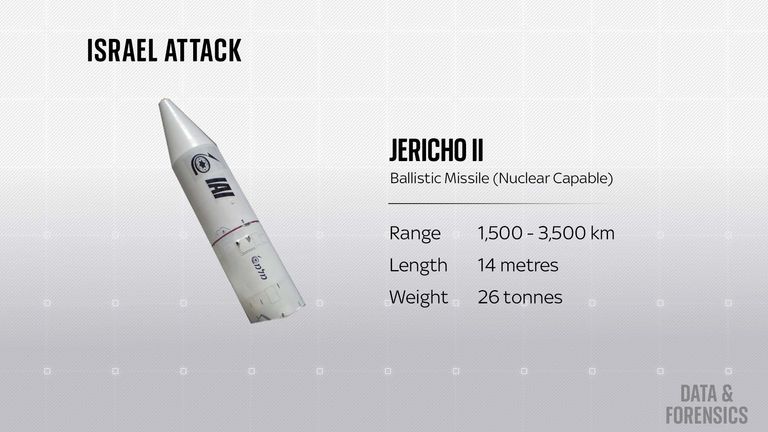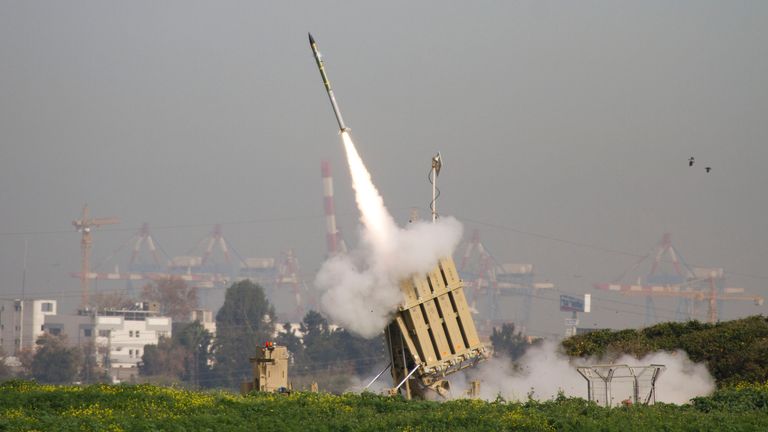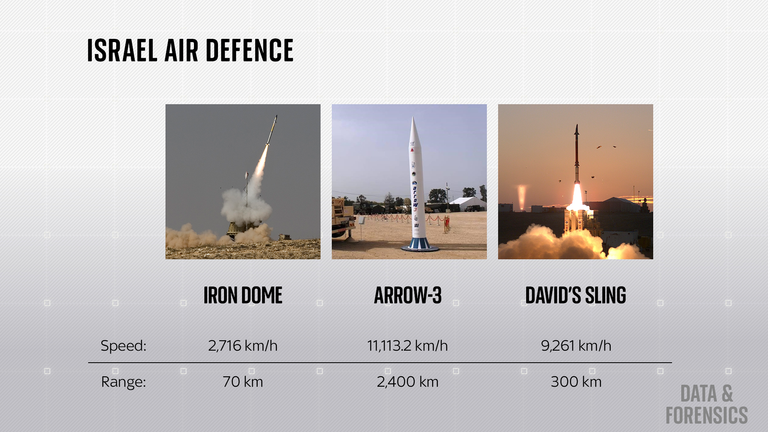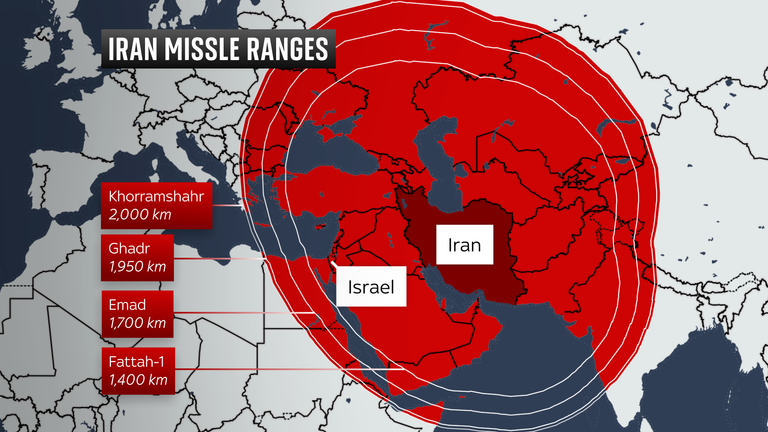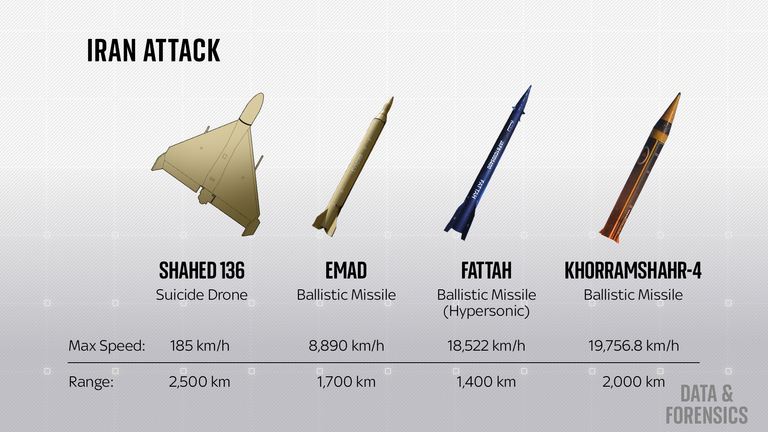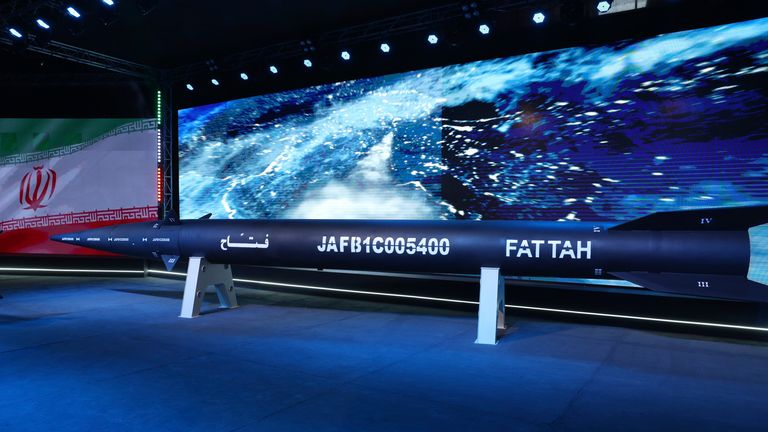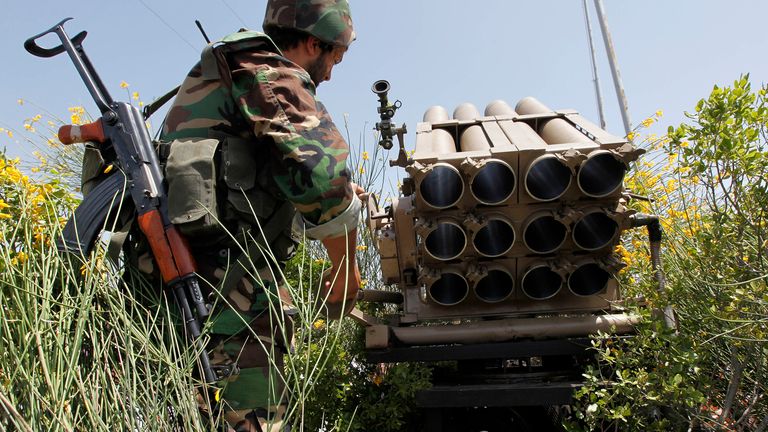Iran’s president has vowed Israel would face a “massive and harsh response” if it attacks, as US officials believe it is planning to do.
Iran launched more than 330 missiles and drones towards Israel on Saturday in response to Israel’s alleged bombing of its Syrian consulate.
On Wednesday, Foreign Secretary Lord David Cameron said he hoped that Israel’s potential retaliation “does as little as possible to escalate this conflict”.
Experts told Sky News that Israel is likely to be considering an airstrike on critical Iranian infrastructure, including air bases and nuclear facilities.
Israel is well-equipped for such an operation. The country possesses 39 state-of-the-art F-35 stealth fighter jets, the fifth largest inventory in the world.
Sky News security and defence analyst Michael Clarke says the planes are “pretty well invisible”.
“It is rumoured that Israeli F-35s have already been around and about Iranian airspace on surveillance missions,” he says.
‘We are 100% ready’
At a military parade on Wednesday, Iran’s president Ebrahim Raisi hailed the attack on Israel and warned against any retaliatory action. “We are 100% ready in all aerial fronts,” he said.
“The Iranians have worked hard on improving their air defences in recent years, but how good they are is an open question,” says Fabian Hinz, a research fellow at the International Institute for Strategic Studies (IISS).
Iran is known to possess at least 42 long-range surface-to-air missile launchers, including 32 Russian-made S-300 launchers that it acquired in 2016.
In 2018, however, it was reported that Israeli pilots had travelled to Ukraine to practice evading the S-300, which Ukraine is known to possess.
As a result, Mr Hinz says, Iran has increasingly invested in designing its own air defence systems.
What air defence systems does Iran have?
One of the first such systems, the Sevom Khordad, was reportedly used to down a US Global Hawk drone over the Persian Gulf in 2019.
An updated version of the Sevom Khordad, the Khordad-15, was unveiled in 2019 and is under the command of Iran’s elite Revolutionary Guards. Iran claims it can engage enemy fighters at a range of 75km.
In 2022, Iran unveiled an updated version of the Khordad-15 called Tactical Hunter. Iran says the system has a range of 120km and is defended by its own short-range missile system.
Two new defence systems were unveiled in February, but it is not yet clear whether they are operational.
The Arman is reportedly able to engage six ballistic missiles simultaneously at ranges of 120-180km, while the Azarakhsh is said to be able to destroy low-altitude targets within a 50km radius.
“I would guess that the Israelis would be quite good at disabling [Iran’s air defences] through jamming and electronic warfare, although we don’t know for sure,” says Mr Hinz.
If Israel wanted to avoid Iran’s air defence systems entirely, it could opt to fire a missile from an aircraft outside Iranian airspace.
Neighbouring countries are unlikely to grant Israel permission to use their airspace, but Mr Hinz says they are also unlikely to try and shoot down Israeli aircraft.
Little is known about Israel’s Jericho missiles
Israel could avoid violating its neighbours’ airspace by utilising ballistic missiles launched from its own territory.
“If Israel carried out a similar ballistic missile attack to Iran, Iran would certainly struggle to intercept it in the same way,” says Jeremy Binnie, Middle East and Africa editor for Jane’s Defence Weekly.
However, it’s unclear whether Israel has the capabilities to launch a similar attack. Israel’s ballistic missile programme, called Jericho, is highly classified.
Few details are in the public domain, but the IISS estimatesIsrael has about 24 nuclear-capable Jericho II missiles.
“They have submarine-launched cruise missiles and ballistic missiles which they almost certainly use for their nuclear deterrent,” says Mr Hinz.
“But do they have conventional, precision-guided versions that they could use? We just don’t know.”
A learning opportunity for both militaries
Of the more than 330 missiles and drones launched as part of Iran’s attack, US officials say that around half failed to launch or crash landed.
Just nine missiles hit their targets within Israel, with the rest being intercepted by Israel, Jordan and Western forces.
“This obviously doesn’t look very successful from Iran’s point of view, but actually they now have a much better idea of Israel’s capabilities,” says Mr Binnie.
However, Mr Hinz says that Israel will also have used the assault as an opportunity to test its air defences.
“With every use of their missile defence systems, they can improve the algorithms, they can improve the operating procedures,” he says.
The Iron Dome, a system of radar-guided missile launchers, has consistently blocked more than 90% of short-range rockets fired towards Israel.
Mr Hinz says that the system has been subject to continuous software updates which have rendered it more effective.
Two other systems, Arrow and David’s Sling, are capable of intercepting ballistic missiles at much further distances. Arrow is capable of flying at hypersonic speeds and intercepting missiles beyond the Earth’s atmosphere.
The US has said that Israel’s air defences proved their effectiveness in the attack, which caused no fatalities and only minor damage.
“But how much can we attribute that to the help from the Americans and others?” asks Mr Binnie.
“Could the Israeli Air Force have shot them all down by itself? Well, it might well have struggled, quite frankly.”
Iran’s attack capabilities have been improving
The attack may also have given Israel a better idea of Iran’s offensive capabilities. Iran has promised to launch a “much stronger” assault if Israel attacks sites within its borders.
On Tuesday, Sky News was shown the remains of an Iranian Emad-1 missile at a military base in Israel.
It is similar to Iran’s Ghadr missile, first tested in 2004, but with additional precision targeting capabilities.
Both missiles have a range of more than 1,500 kilometres – putting all of Israel well within their sights.
“I would say that what they fired is basically what they have in their arsenal,” says Mr Hinz. “It’s not that they restrained [themselves] and just used their less sophisticated weapons.”
One possible exception is the Fattah, an Iranian-designed weapon unveiled last year.
“They’ve shown us testing footage, but we don’t know if it’s operational,” Mr Hinz says.
A rocket motor on the warhead of the Fattah could allow it to conduct evasive manoeuvres outside the atmosphere and to increase the speed of its final descent.
“It’s specifically designed to beat Israeli air defences,” says Mr Binnie.
Another missile unveiled last year, the Khorramshahr, is still thought to be under development.
“The Khorramshahr has a big old warhead on it, 2,000kg, so in theory that’s going to be quick and harder to intercept,” Mr Binnie says.
Read more on Sky News:
Is it safe to travel to holiday destinations as Middle East tension escalates?
Are we heading for World War Three? Experts give their verdicts
It’s impossible to know how these weapons will perform against Israel’s air defences until they are actually used.
“The precision they’ve achieved is quite impressive, but it doesn’t really help if your opponent’s defensive systems are even more impressive,” Mr Hinz says.
For Iran to cause significant damage to Israel, it may have to rely on increasing the quantity, rather than the quality, of its missiles.
“There will be an upper limit at some point where you’ve got so many ballistic missiles coming in, Israel just can’t shoot them all down,” says Mr Binnie. “What that point is, we don’t know.”
The US estimates that Iran’s arsenal includes more than 3,000 ballistic missiles, but it’s not clear how many it would be able to launch at once.
Mr Hinz says that the logistical effort in launching 120 missiles simultaneously will already have been enormous – likely involving hundreds or thousands of people.
“Can they scale it up? My guess would be that they could, but perhaps not to a large degree.”
If Iran wants to overwhelm Israel’s air defences, it is likely to rely on the involvement of Lebanese militia Hezbollah. Lebanon is just 115km from Tel Aviv, whereas missiles fired from Iran must travel more than 1,000km to reach Israel’s capital city.
“They’re just much closer to Israel and so they can use much cheaper systems,” Mr Hinz says. “As a result, they have many, many more than Iran.”
The CIA estimates that Hezbollah has more than 150,000 missiles in its arsenal.
The risk for Iran would be that Israel responds forcefully against Hezbollah, one of its most valuable allies. In December, Israeli Prime Minister Benjamin Netanyahu threatened to turn the Lebanese capital Beirut “into Gaza”.
Ultimately, Mr Hinz says, it could come down to a matter of attrition.
“If this becomes a sustained confrontation, someone is going to run out of missiles first,” he says.
“Does Iran have more ballistic missiles, or does Israel have more interceptor missiles? We just don’t know.”
Additional reporting by Sam Doak.
The Data and Forensics team is a multi-skilled unit dedicated to providing transparent journalism from Sky News. We gather, analyse and visualise data to tell data-driven stories. We combine traditional reporting skills with advanced analysis of satellite images, social media and other open source information. Through multimedia storytelling we aim to better explain the world while also showing how our journalism is done.


